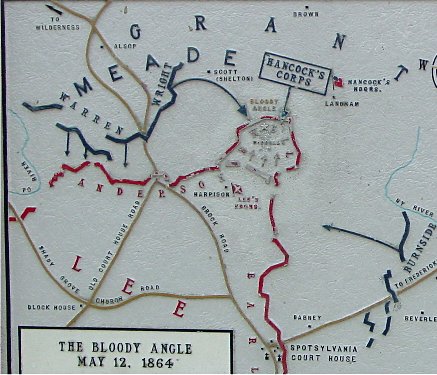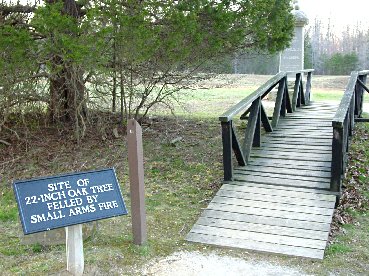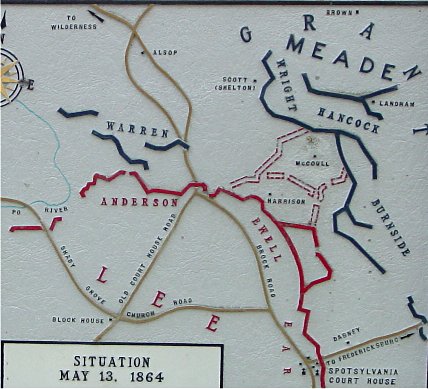Spotsylvania - Mule Shoe
Attack
May 12, 1864
 |
With the near success of Upton's attack on the
Mule Shoe salient, Grant planned a massive assault with the entirety of
Hancock's II Corps and two divisions of Wright's VI Corps, in all 20,000
men. To the right, Warren's V Corps was to attack along his front, while
to the left, Burnside's IX Corps was to attack along the eastern side of
the salient. The attacking Union troops marched through the rainy night
of May 11-12 to the jump off position and slept on the muddy ground.
Meanwhile, Lee received intelligence leading him to believe that Grant was retreating.
Artillery was removed from the salient for a pursuit, but Gen. Ewell
commanding the Second Corps ordered them back when he
suspected a Union attack was imminent. Many of the guns did not make
it back in time.
|

The East Angle - II Corps Attack
This is a panorama from in front of the tip of the salient,
the East Angle. At 4 A.M. on May 12th,
Hancock's II Corps, attacking along the axis of the mowed path, broke through in a dense fog. The defending Confederates could
see little through the fog and confused the attacking Federals for their own pickets.
Soon Edward "Allegheny" Johnson and most of his Confederate division were
captured along with Gen. "Maryland" Steuart.

VI Corps Attack
Meanwhile on the western face, Birney's division, with
Mott's division in support, advanced on the Confederate works generally along
the axis of the mowed path. The Federals
advanced from the distant woods over a swampy area
and up the hill to the Rebel position. Also aided by surprise and the fog,
this portion of the Union attack also broke through and captured a number of
Confederates. They then headed down the western side of the entrenched
line and captured most of the
remains of the famed "Stonewall" brigade.

McCoull House
The advancing Unionists from Birney's and Mott's divisions
advanced down the western side of the salient on the left of the picture,
pushing back rebels along the main and reserve lines. Meanwhile, Barlow's
division advanced down the eastern side and into the woods in the center
of the salient. These woods are on the center and right of the picture.
At the base of the salient, division commander John B.
Gordon sent two brigades in the the fields and woods near the McCoull house
but both were pushed back, but Gordon had more men and troops on the western
face wheeled to meet their foes while men of Mahone's division moved in from
the reserve. Hoffman's and Evans' brigades attacked the Yankees to
the right of the McCoull house and into the woods. Daniel's, Ramseur's,
and Perrin's brigades attacked to the left of the McCoull house. In
confused fighting, the Confederates pushed back the disorganized Federals
and regained most of their original defensive line.
The fighting was not over, however. The Union
penetration lasted only a couple of hours, but fighting continued at the
fortifications for the rest of the day, with two divisions from the Union
VI Corps joining the fight. The fighting was so severe, a 22 inch
oak tree was literally shot down by minie balls. Soon after the war,
the artifact was "liberated" from its owner by the Union army, and it is
now exhibited in the Smithsonian.
|
 |
Although they attacked, no significant support came from the Union
V and IX Corps. But at the end of the day, the Confederates withdrew to the
base of the salient. In some places Confederate dead had fallen five
deep and were buried in shallow graves made from their own trenches. This
had been some of the most horrifying combat of the
war.
In all, Lee's army lost around 6,000 men that day, with
3,000 of them men captured from Edward Johnson's division. Grant's
army lost 7,000 men in the attack, and nearly 37,000 since the beginning
of the Overland campaign. After trying to flank Lee on the 14th, Grant
ordered a failed attacked the base of the salient on the 18th. On the
20th, Grant continued the march south. He would next meet significant
resistance at the North Anna River.
|
 |
Back to Spotsylvania





